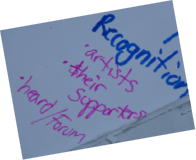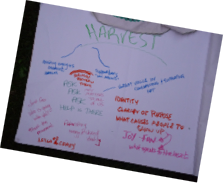Earlier this month I blogged about a planning tool, Chaordic Stepping Stones, that I was using to map a conversation with our local practitioners circle. I referenced there, that this is a tool I use all of the time. Particularly, when I’m starting with a client. I find it is a great way to hear the story of what is happening and what is wanted.
In skimming through some old email on the plane yesterday, I found this description from buddy and colleague Chris Corrigan. Chris outlines a series of three conversations that help to ground a project well. Big thanks.
“I often lump together the first four “stones in one conversation: what is the need, purpose, principles and people? Once we know those we have a handle on the kind of thing we are planning and we have enough material to also create a first level invitation.
The second conversation can look at limiting beliefs, concept and structure which gives us a good sense of what we should be doing and how to support it, and what work we need to do on ourselves to get where we are going. That gives us a second level of invitation as well. We can send out a note to our people about how we aim to meet the need and purpose.
The third conversation is on practice and harvest, in other words, the feedback loops and artifacts that will be most useful.
So these three conversations are quite useful ways to me of grouping together the various stages of planning a meeting or an initiative. It weighs heavily towards purpose and need, which I think is a good thing, as getting clarity on that can be very generative. I don’t mean getting a clear statement, but rather, its a felt sense of purpose that is shared and enables us to act rather than constraining action (“oh, we can’t do that, it’s not in our purpose”).”

 unding, resources, and recognition for local artists.”
unding, resources, and recognition for local artists.” We asked people to share some of what they felt was particularly energizing. To name what they were hearing — to be another set of ears to help name for Tay what was present in the circle. Much richness there about building bridges between artists and supporters; awareness that art matters to all of us; just go with who is going with you to start a movement; letting go of any feelings of being crazy; strengthening an identity with clear purpose; working with joy and fun that speaks to the heart.
We asked people to share some of what they felt was particularly energizing. To name what they were hearing — to be another set of ears to help name for Tay what was present in the circle. Much richness there about building bridges between artists and supporters; awareness that art matters to all of us; just go with who is going with you to start a movement; letting go of any feelings of being crazy; strengthening an identity with clear purpose; working with joy and fun that speaks to the heart.